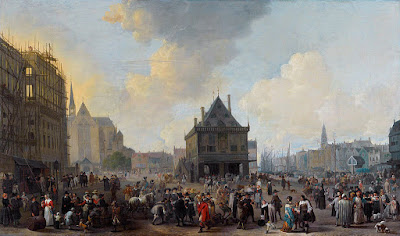HISTORY
The Holy Roman Empire ruled much of the Low Countries between the ninth and eleventh centuries, but was not able to maintain political unity. In time, the local Dutch feudal lords, headed by the count of Holland and the bishop of Utrecht, became practically independent. Many Dutch towns during the Middle Ages were prosperous trading centres, usually ruled by small groups of merchants.
 |
| The Low Countries in the late 14th century. By Sir Iain - Wikipedia Commons |
In the 15th century the Low Countries (The Netherlands, Belgium, Flanders) were systematically united by the dukes of Burgundy.
The Netherlands became part of Spain when in 1477 Mary I of Valois, Duchess of Burgundy married Maximilian I of Habsburg, Emperor of the Holy Roman Empire.
In the 16th century many Dutch people became Protestant. This did not endear the province to Catholic Spain and everyone in the Netherlands was sentenced to death by the Spanish Inquisition in 1568.
The seven northern provinces of the Low Countries got together in 1579 to rebel against the Spanish beginning a war of independence known as The Eighty Years War. Two years later, the Republic of the Seven United Netherlands declared its independence from King Philip II of Spain on July 26, 1581 with the Act of Abjuration.
 |
| First page of the Act of Abjuration |
The Eighty Years' War ended in 1648 with the Peace of Westphalia, with Spain formally recognizing the independence of the Dutch Republic.
In an early 17th century Europe that was being torn by religious intolerance, The Netherlands was the only country that embraced every variety of freedoms. Consequently Protestant and intellectual refugees poured into the Dutch cities fleeing from persecution. This influx bought many benefits, its universities were centers of excellence, literature and art flourished and trade bloomed.
 |
| Amsterdam's Dam Square in 1656 |
The Dutch Golden Age spanned much of the 17th century as the Dutch Empire grew to become one of the major seafaring and economic powers. By 1650, the Dutch owned 16,000 merchant ships.
The Kingdom of Holland was formed on June 5, 1806. Napoléon's brother Louis Bonaparte was installed as a puppet king.
Louis Bonaparte was known as and is still called The King of Rabbits because he mispronounced the Dutch phrase "I am your king" and instead said "I am your rabbit" when he took over the Netherlands.
Four years later, on July 9, 1810 Napoleon annexed the Kingdom of Holland as part of the First French Empire. The Netherlands remained part of the French Empire until the autumn of 1813, when Napoleon was defeated in the Battle of Leipzig. and the Netherlands became independent again.
A Royal Decree issued by Queen Wilhelmina on February 19, 1937 laid down the heraldic colors of bright vermilion, white and cobalt blue as the national flag.
In 1940 Netherlands was invaded and occupied by Germany.. During the five years of Nazi occupation, 250,000 Dutch people were killed.
In 2001, The Netherlands became the world's first country to legalize same-sex marriage.
FUN FACTS
What is the difference between Holland and the Netherlands? 'Holland' comprises two of the 12 provinces of the Netherlands: North and South Holland.
"The Netherlands" means "the low lands". The land only rises, on average, 1 meter above the sea level. 27% of The Netherlands lies below sea level.
 |
| Map illustrating areas of the Netherlands below sea level |
The reason for the Netherlands not being underwater is due to its complex network of dikes, ditches, canals and pumping stations that have been built through the course of its history. If the Netherlands stopped all water management 40% of the country would be flooded within weeks.
The Dutch are the tallest people on Earth. The average height of a Dutch man is 6 feet or 184 centimeters.
The average height of a Dutch male has gained 20 cm (eight inches) in the last 150 years, according to military records.
With a population density of 408 people per km2 – 505 (July 2016) if water is excluded – the Netherlands is most densely populated European country. 90% of its 17 million inhabitants live in urban areas.
The Netherlands has 17 million people and 18 million bicycles.
Despite being a tiny country with a large population density, The Netherlands is the world's second-largest exporter of food and agricultural products, after the United States. This is due in part to the fertility of the soil and the mild climate.
Hagelslag (chocolate sprinkle and butter sandwich) is a very common food item for breakfast and snacks in the Netherlands. An estimated 750,000 Hagelslag are eaten each day.
Rotterdam was the world's largest port between 1962 and 2004 and still is currently the largest port in Europe – as large as the next three largest combined.
The Dutch village of Giethoorn has no roads; its buildings are connected entirely by canals and footbridges.
Source Daily Express
Rotterdam was the world's largest port between 1962 and 2004 and still is currently the largest port in Europe – as large as the next three largest combined.
 |
| The Port of Rotterdam is Europe's largest port.. By Joris - Wikipedia Commons |
The Dutch village of Giethoorn has no roads; its buildings are connected entirely by canals and footbridges.
Source Daily Express

No comments:
Post a Comment